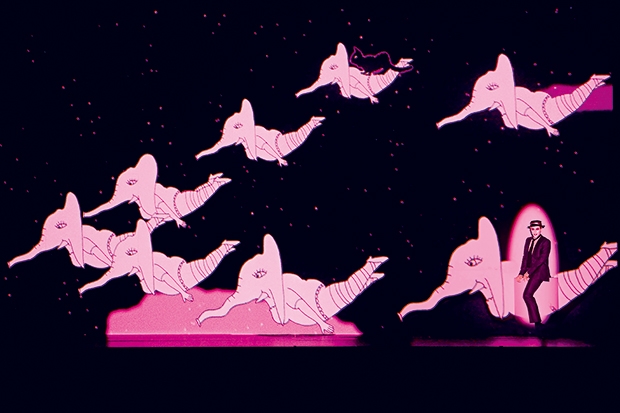London may cry foul over Hamlet’s misplaced to-be-ing and not-to-be-ing but Edinburgh is in raptures over a Magic Flute which ditches its spoken dialogue entirely. Directed by Barrie Kosky and Suzanne Andrade, and first seen a couple of years ago on Kosky’s adopted home turf at the Berlin Comic Opera, the production turns Mozart and Schikaneder’s beloved singspiel into a sing-stumm, in which silent-movie captions and moon-faced gazes replace the original spiel, underscored by fortepiano improvisations with a spot of Chinese opera thrown in for good measure.
Not your usual night at the opera, then, but it certainly drove the Festival Theatre audience wild. The visual style mixes up Buster Keaton, F.W. Murnau and Monty Python, with the action dominated by slick animation sequences projected on a drop screen in which cut-outs revolve to reveal the live singers on promontories of varying precariousness. The opera’s first number finds Tamino’s torso swaying atop projected running legs. The character thus seen fleeing towards us, hotly pursued through a geometric jungle by a cartoon dragon. By the time the dragon’s fire is extinguished by the three ladies’ nonchalant exhalations of cigarette smoke, the sense of who’s who and what’s what is already well established: Pamina is Louise Brooks; or, rather, all women are, except the Queen of the Night, a black widow, and Papagena, a stray chorus girl from the Rue Pigalle. Monostratos is Nosferatu, the three boys are butterflies, Sarastro is Brunel, obviously, and Papageno has a black cat and magic bells that dance the can-can.
The animation is the work of Andrade’s creative partner Paul Barritt and is cleverly integrated and unremittingly charming, unveiling a virtual vaudevillian world in which the opera’s childish allegorising, for once, makes perfect cartoonish sense.








Comments
Join the debate for just £1 a month
Be part of the conversation with other Spectator readers by getting your first three months for £3.
UNLOCK ACCESS Just £1 a monthAlready a subscriber? Log in